Fleas are not only major issues among dog owners; these are valid concerns among cat lovers. With more than 2,500 species of fleas worldwide, a very hardy outer shell once it reaches its pupae stage, and a prolific egg layer, these Siphonapteric parasites can be very stubborn to control. Therefore, the current recommendation is for appropriate flea treatment medications and environmental control. Unfortunately, even the most reasonable and well-planned flea pest control program can never fully eradicate these ectoparasites. However, we can always minimize these pests' damage to our beloved pets. For that, we need to start with the use of only the best flea treatments for cats.
The Best Flea Treatment For Cats
1 Bayer Advantage II Flea Treatment For Cats
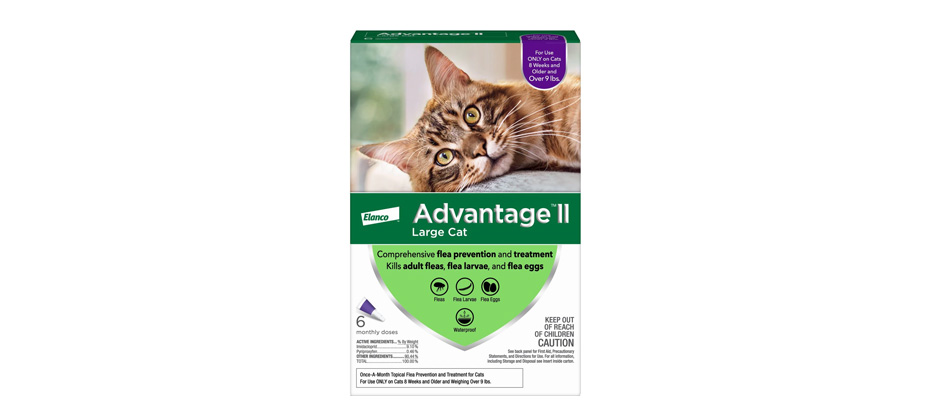
- Contains Imidacloprid and Pyriproxyfen
- Kills adult fleas on contact
- Eliminates flea bite dermatitis
- Controls juvenile forms of fleas
- One-monthly topical application
- Waterproof formulation
What makes the Advantage II flea treatment for cats one of the world’s best is that it kills fleas in all 3 of their highly vulnerable stages: eggs, larvae, and adults. For adult Siphonapteroids, they are immobilized and killed upon contact, usually within the first 12 hours after application of Advantage II flea medicine for cats. It is also effective in killing fleas that reinfest your pet’s skin within 2 hours. They don’t need to bite into your cat’s skin for the active ingredients of Advantage II to start eliminating these pests. This is welcome news for those who may have pet felines that are quite sensitive to insect bites that they form rashes, itching, blisters, and even swelling on the skin.
Advantage II contains both Imidacloprid and Pyriproxyfen. The former exerts its action by blocking nerve impulse transmission in the pest which leads to its paralysis and eventual death. On the other hand, Pyriproxyfen works by preventing the juvenile forms of fleas to grow or reach maturity. This effectively breaks the cycle since no eggs and larvae develop into pupae where they can mature into highly gravid adult fleas. It is this combination of a powerful insecticide and an insect growth inhibitor that makes Advantage II one of the best flea treatments for cats. It is also waterproof and very easy to apply. Once-monthly application is recommended to achieve the best results.
Active Ingredients: Imidacloprid 9.1%, Pyriproxyfen 0.46%.
2 Merial Frontline Plus For Cats
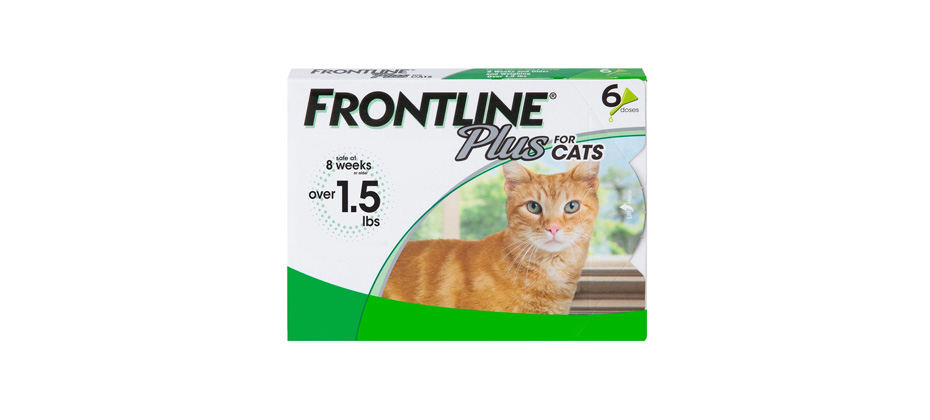
- Contains Fipronil and S-methoprene
- Kills fleas across the lifespan
- Kills lice and ticks
- Fast-acting and easy to apply
- Once-monthly application
If the action of Advantage II is to block the transmission of nerve impulses in adult fleas leading to their paralysis, the mechanism of action of Frontline Plus is the opposite. Its active ingredient, Fipronil, is well-known to cause hyper-excitation of the nerves, leading to seizures in the affected insect. Because of the intense contractions of the muscles and the abnormal firing of the neurons of the flea, it can no longer support optimum neurologic functioning leading to its death. Technically, the end result is pretty much similar to Advantage II. There is loss of neurologic functioning leading to the pest’s demise. In addition to Fipronil, Frontline Plus also contains S-methoprene which is effective against juvenile Siphonapteroids.
So, what makes Frontline Plus an excellent flea treatment for cats? Well, in addition to killing fleas in all of their developmental stages, it is also effective against ticks and lice. This is something that you cannot find in Advantage II. Technically, if you have flea- tick- and lice- infestation in your neighborhood, then Frontline Plus tick and flea control for cats is an excellent choice. It works fast, lasts 30 days, and is waterproof, although Merial advises waiting a full 24 hours after application before allowing your feline pet to get wet.
Active Ingredients : Fipronil 9.8% , (S)-methoprene 11.8%.
3 PETARMOR Flea Treatment For Cats
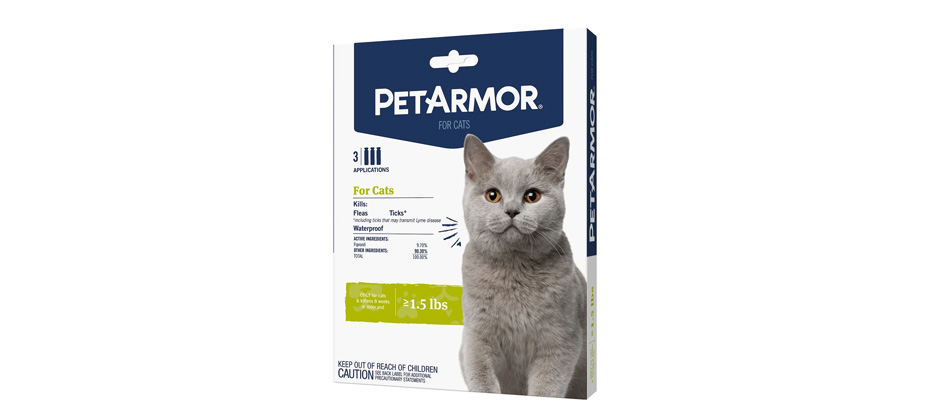
- Similar chemical profile and insecticidal effectiveness with Frontline Plus
- Kills fleas, lice, and ticks
- Easy to apply and waterproof
- Priced lower than leading brand
Want a cheaper version of Frontline Plus? If so, then FidoPharm’s PetArmor tick and flea treatment for cats in squeeze-on preparation is your best bet. It essentially has the same active ingredient as in Frontline Plus, Fipronil; although we are not really sure if it also contains S-methoprene. With the presence of Fipronil, however, you can expect it to be good against fleas, ticks, and lice, too. And if you’re going to look at the marketing strategy of PetArmor, emphasis is placed on its ability to kill various species of ticks. PetArmor is thus, a flea medicine that is also effective against other disease-carrying vectors like lice and ticks. It is easy to apply, works relatively fast, and confers month-long protection for your pet cat. It’s waterproof, too.
Active Ingredient s: Fipronil: 9.70%
4 Elanco Topical Flea Treatment For Cats
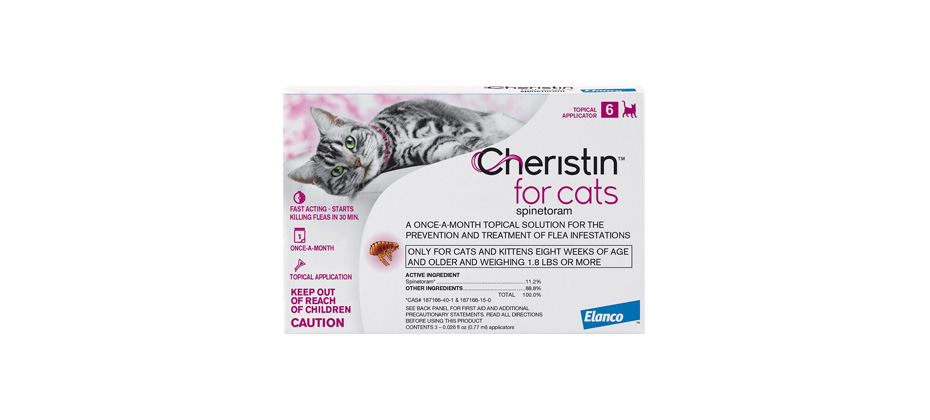
- Novel, powerful Spinetoram active ingredient
- Combines the flea-killing effectiveness of Imidacloprid and Fipronil
- Fast acting,month-long protection
- Easy to apply
- Doesn’t emit an offensive odor
If you’re looking for a flea medicine that is specifically formulated for cats, not dogs or any other pet, then Elanco’s Cheristin is the best option for you. The key to its feline specificity in killing fleas is its unique ingredient – Spinetoram. What is particularly remarkable about the active ingredient of Cheristin is that it exhibits the mechanisms of action of both Imidacloprid and Fipronil by working on both the nicotinic and GABA receptors, respectively, of the flea’s nervous system. In effect, it produces paralysis in some parts and massive seizures in the other, ultimately leading to the killing of the flea. This flea treatment for kittens and adult cats is only effective against fleas, however. Nonetheless, it doesn’t emit an offensive odor upon application which is quite pleasant as cats won’t be stressed out. Cheristin provides the same 1-month flea protection conferred by other products and starts killing pests within 30 minutes of application, often reaching full coverage in as little as 12 hours. It can also be used with other insecticides because of its low cross-reactivity to other chemicals. This makes it a lot safer to use if your cat’s only problem is flea infestation.
Active Ingredients: Spinetoram 11.2%
Other Ingredients: 88.8%
5 Elanco Fast-Acting Oral Flea Treatment
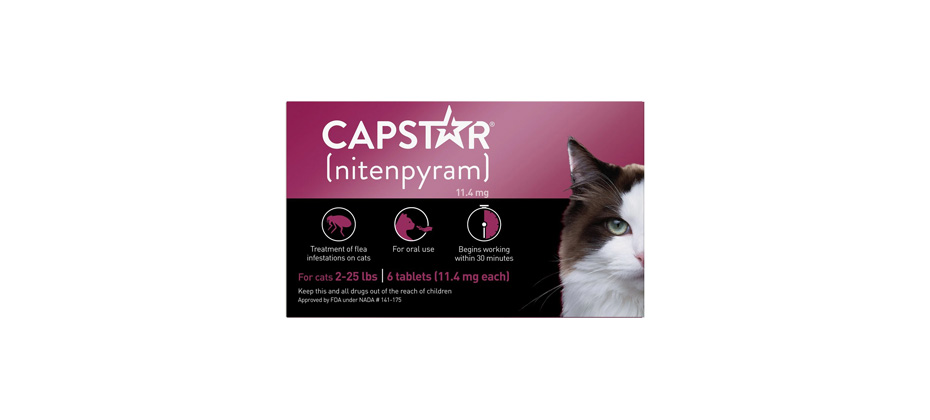
- Rapid flea killing effect that lasts 48 hours
- Kills adult fleas
- Easier to administer
- Used in conjunction with other treatments
The issue most pet owners have with topical applications is that they will never really know if the full dose of the flea medicine has been absorbed through the cat’s skin. Unless you have a kitty that doesn’t have any hair or fur, some of the liquid in topical applications can be wiped onto the hair shaft. To help assure your pet gets the correct dose you may want to give tablet forms of flea treatments for cats instead. And when it comes to tablet flea medicine formulations, Capstar is the best. Boasting of Nitenpyram as its active ingredient, Capstar is known to kill fleas in just 30 minutes, typically continuing its insecticide activity for a whole 48 hours, peaking in as little as 6 hours upon consumption. Understand that Capstar is not intended for long term control of feline fleas. It is more of an adjunctive solution to other flea management protocols especially those involving the use of Lufenuron. Capstar only kills adult fleas and as such it is often important to make it as part of a larger program of insect control.
Active ingredients: Nitenpyram 11.4mg
6 SENTRY Pet Care Flea And Tick Topical For Cats
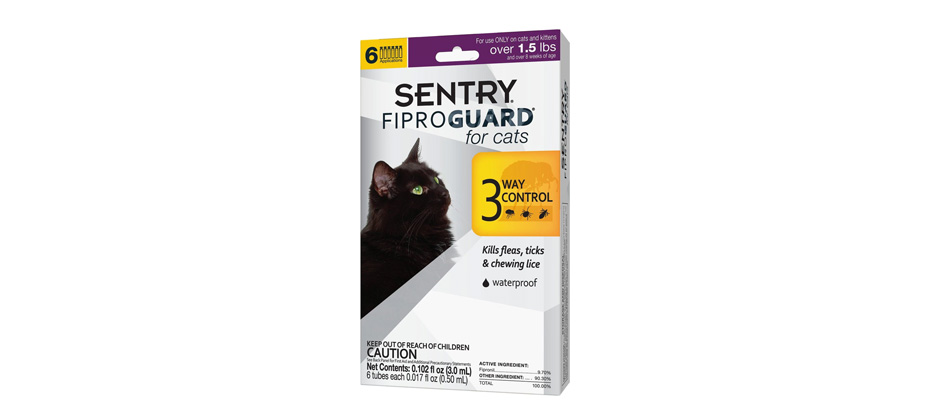
- Same active ingredient as in the leading brand of flea control for cats
- Effective against ticks and lice, not only fleas
- A lot more inexpensive than other brands of the same formulation
Another Frontline Plus alternative is this flea treatment for kittens and adult kitties from Sentry. Fiproguard contains the same active ingredient as Frontline Plus, thus conferring your pet with the same month-long protection, rapid acting insecticidal action, and effectiveness against fleas, lice, and ticks. Fiproguard is also topically applied in between the shoulder blades of your cat. If any, Sentry’s Fiproguard provides an even cheaper alternative to both Frontline Plus and FidoPharm’s PetArmor.
Active Ingredients : Fipronil 9.70%.
7 Bayer Advantage Once-A-Month Flea Treatment
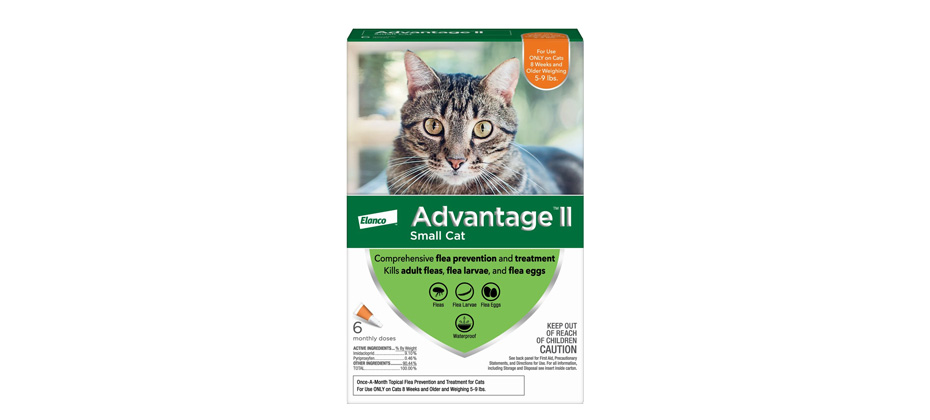
- Contains flea adulticide Imidacloprid
- Easy once a month dosing
- Adulticide activity reached within 12 hours
You might ask yourself why some people would still purchase Advantage when there is already the newer and more improved Advantage II made by the same company. Before you start judging people, it is best to identify the difference between these two products. Technically, the only difference is in their active ingredients with Pyriproxyfen already added to Imidacloprid in Advantage II. Now, understand that Pyriproxyfen primarily targets juvenile fleas such as eggs and larvae. Because Pyriproxyfen is not included in the Advantage Once-a-Month Topical Flea Treatment for Cats, one can always think that this is best reserved for killing and eradicating adult fleas. And since it is technically a flea adulticide, then it can be categorized as belonging to the group of Capstar and Capguard, although the latter two are in tablet form. That being said, this is especially useful for pet owners who may already have instituted other insect control protocols and will only need Advantage’s adulticide functionality to kill any remaining adult fleas. Performance-wise, it’s basically the same as the Advantage II.
Active Ingredients: Imidacloprid 9.1%, Pyriproxyfen 0.46%.
8 Wondercide Flea Control Spray For Cats

- Kills adult insects and pests that bite
- Made of safe, all-natural, organic ingredients
- Effective as a repellent
For those who are quite averse to giving their pets synthetic ingredients, Wondercide’s All Natural Flea Control Spray for Cats should be appealing. Do take note that this is not really a flea medicine for cats and kittens but rather as a natural solution that you spray onto various surfaces in your home which you suspect might be breeding grounds and hiding places of fleas. That said, it can also be safely sprayed onto your pet’s coat to confer it some form of protection against adult fleas, flies, ticks, and mosquitoes. It is composed of a blend of natural essential oils that have been proven to have antiparasitic and insecticidal properties, including organic lemongrass and cedar oil. And since it is made from only natural and organic ingredients, its safety is unquestionable. However, it may not be as effective as the other products in this list since Wondercide is only effective against biting pests. It repels them, nonetheless.
9 Catego Flea And Tick Control For Cats
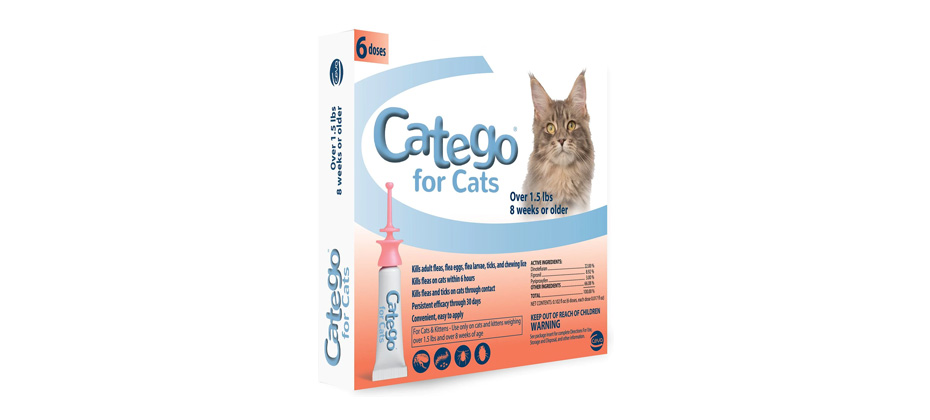
- Unique cats-only formulation
- Contains 3 powerful ingredients: Dinotefuran, Fipronil, and Imidacloprid
- Faster flea-killing effects than Advantage and Frontline Plus
- The same month-long protection
- Ease of application
Featuring three active ingredients that closely resembles the chemical profile of Advantage II and Frontline Plus, Ceva Animal Health’s Catego for Cats could very well be one of the best flea treatments for cats because of its unique chemical formulation. First off, it contains Dinotefuran which is a lot similar in pharmacologic action to Imidacloprid especially in the inhibition of nicotinic receptors in the flea nervous system. Catego also contains Fipronil which we already know as effective in inducing death in fleas by creating hyperexcitability in their nervous system structures. Thirdly, Catego contains Pyriproxyfen which is an insect development inhibitor, technically robbing the flea of any capability to reproduce by altering the growth and development of eggs and larvae. Because of this remarkable combination of active ingredients, one doesn’t need to wait 12 hours before majority of the fleas in your pet are killed. Unlike Advantage II and Frontline Plus that typically work their wonder within 12 hours, Catego accomplishes this in half the time. It also kills adult and juvenile fleas, lice, and ticks and can be easily applied once every 30 days. If any, Catego flea treatment is a lot like Cheristin in that it is specifically manufactured for cats only.
How to Choose the Best Cat Flea Treatment
We understand that choosing a flea medication for cats can be exceptionally frustrating as almost every other product on shelves looks essentially the same. The only way to pick the right one is by equipping yourself with the correct knowledge and skills for selecting such products.
In this section of this post, we have prepared a comprehensive guide that will help you make that all-important decision as to which among the various products available in the market you simply need to pick. We have also included a listing of the different types of cat flea treatments that you might be interested in, focusing more on their insecticidal effectiveness and ease of application. Towards the latter portion of this article, we’ll be providing you with some helpful tips on how you can maximize the full benefits of these flea treatments.
What Should I Look for in the Right Flea Medication for My Cat?
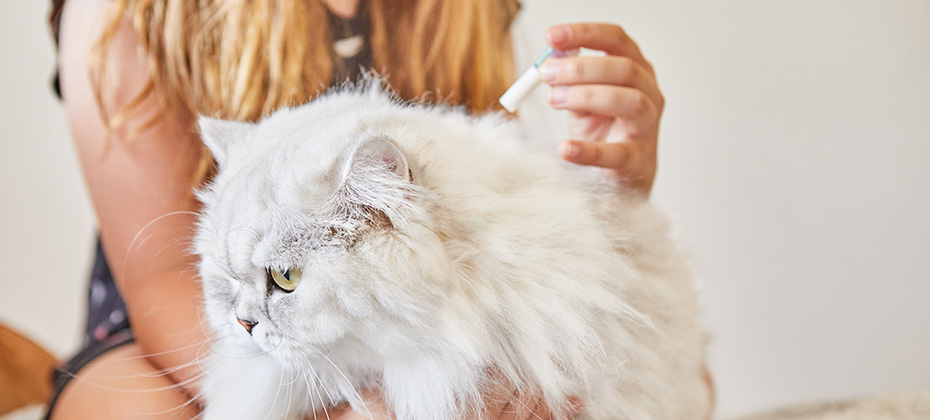
Choosing the right flea medication for your cat can be very easy. Unfortunately, many new pet owners are having trouble identifying the right flea control for cats. If you’re in the same predicament, you’d be glad to know that we’ve set up this list of things you will have to look for when choosing the right anti-flea product for your feline friend.
Quick-Acting and Reliable
Fleas are very prolific creatures. They don’t need many months from eggs to adults until they reach their full reproductive capacity. That is why you may kill some of these pests today, but tomorrow some of them will already be crawling back to your hapless pet. This is how resilient and prolific these ectoparasites are. And it is also for this reason that you are not supposed to be content with using flea medications on your pet alone. This should also be coupled with prudent management of your environment, especially in areas your pet frequents.
That being said, a product’s ability to exert its insecticidal action is crucial. You don’t want to wait a couple of days before seeing dead fleas on your cat because if this is the case, you’ll be left with a still-flea-infested pet.
Quick-acting is quite different from the rapid onset of action, however, and it would be wise to read the label of these products carefully. Some would say 30 minutes, while others will say they require 12 hours or even 24 hours. For those products that put the 30-minutes in their label, this is often a reflection of the onset of action. It means the time it would take for the drug to begin exerting its flea control activity. For example, if you administered the flea medication now, you should expect to see a few dead fleas within 30 minutes. But this does not mean that you have eradicated the problem.
This is where peak onset comes in. What products that put 12 hours or 24 hours on their labels mean is that most of the fleas in your pet are already killed within this given time frame. So, after 12 or 24 hours, you can expect up to 99% of all fleas already dead.
As much as possible, you would want a flea control product that can give you a fast onset of action, a fast peak onset, and extra-long therapeutic effectiveness. For instance, you will be better off with a product that begins killing fleas in 30 minutes after application or administration, killing 99 percent of these pests within 6 hours, and extending this flea-killing property for up to 30 days or perhaps even longer.
That said, two of the most important things you need to look for are a product’s fast onset of action and its reliability. The greater the percentage of fleas and other pests it can kill in less time, the better.
Controls Fleas in Their Various Life Stages
We have already mentioned that fleas are very resilient creatures. Each stage of their life cycle presents a challenge. As such, the effectiveness of a product is largely anchored on its ability to address these life stages.
Fleas start as eggs, often found in dark, moist, and warm places. After a few weeks, they hatch and become larvae that feed on almost anything organic. This flea stage cannot jump, but it can latch onto almost anything because of its strong mouth. One weakness, though, is that they are especially vulnerable to heat. These larvae are well hidden in deep crevices and cracks on the floor and in your backyard. After a few weeks, larvae form a cocoon to protect themselves from the environment. This is the stage where it simply is very difficult to destroy. The maturing flea is well-protected inside its cocoon. It waits for the right moment and stimulus to break through its casing and become an adult, where it lays eggs and starts the process all over again.
Killing the adults will typically address the problem. However, the eggs, larvae, and pupae that remain to become adults will still have to be contended with. Killing the eggs is nearly impossible since they are so small and are well hidden from view. However, those already present on your pet’s skin should be highly vulnerable to the effects of insect development inhibitors. What happens is that they no longer have the capacity to form the super-hard protective shell of the pupae. This exposes them to a lot of danger and can ultimately lead to their deaths.
As you can see, the only way to eradicate fleas is to ensure you have a product that addresses each of these life stages. Of course, this should also be combined with thoroughly treating your house, belongings, backyard, and, if possible, the entire neighborhood.
If in case a product only kills fleas at a certain stage in their life cycle, then you need another product to manage the other life stages.
Relatively Safe with Minimal Side Effects
Different preparations of flea medications for cats can produce a variety of clinical complaints. For example, topical preparations can irritate or burn the skin of those cats with highly sensitive integuments. In some cases, staining can also occur. As for tablets, there is always a risk of gastric irritation and stomach upset. So, it is always advisable to let your vet check your pet first so any hypersensitivity can be established and the more appropriate formulation is identified.
Additionally, different chemical ingredients are known to produce various side effects. For example, if a topical flea treatment that contains Fipronil is licked by your pet, then there is a chance that nausea and vomiting, abdominal pain, weakness, dizziness, and even tonic-clonic type of seizures can occur. That is why it is important to know how to administer these topical products correctly to avoid getting these ingredients licked and ingested by your pet feline. As for Nitenpyram, excessive panting, as well as hyper-excitability, has been seen in pets 2 hours after the administration of the flea medication for cats.
It is, thus, imperative to choose a product that does not bring any additional harm to your feline friend. Side effects are a mainstay in all medications. Just pick one that doesn’t include life-threatening adverse reactions.
Ease of Application or Administration
Suffice it to say the ease of application or administration of the product matters, too. If you got a cat with very thick fur that you’re not sure if all of the contents of a topical formulation are absorbed by its skin, then you might want to stick with a tablet form or some other type of flea treatment.
Related Post: Probiotics for Cats
What are the Different Types of Flea Treatments for Cats?

Since one of the factors you need to consider when choosing an appropriate flea treatment for cats is the ease of application, you must also be well-versed in the different anti-flea medications.
Topical Applications
These are very easy to apply and are considered very effective in killing and preventing various pests from infesting your pet. Many of these products are available without a prescription, making them relatively easy to obtain. They work because the active ingredients are slowly absorbed into the bloodstream through the skin, quickly paralyzing and inactivating fleas already present on the pet’s skin. Certain formulations also emit the active ingredients as toxic fumes, and only pests are affected. This provides its repellent action.
Tablets
Tablet formulations of flea medications are just some of the latest innovations in pest control. These work by providing a highly concentrated dose of the active drug to instantly kill adult fleas. Sadly, these do not kill flea eggs and larvae, necessitating the administration of another drug specifically designed for such a purpose. As such, these formulations are primarily intended as an adjunct to other longer-term treatments, especially those that contain ingredients targeting eggs and larvae.
Oral Drops
These are similar to topical applications, with the sole difference of the drug being ‘dropped’ into the mouth of your feline pet instead of being applied onto its skin. It is equally effective but may not sit well with felines that are not good at taking medications via the oral route.
Shampoos
Most of us think cats are particularly averse to taking a bath. However, this should be made a part of their regular grooming. Bathing also has the added benefit of allowing you to visually inspect your pet’s skin for any signs of flea eggs, larvae, or even adult fleas. In such cases, you can always apply flea-medicated shampoos. Unfortunately, this is not that effective as a repellent, especially if your kitty happens to be a lover of the great outdoors. Also, its flea repellent smell typically fades over time.
Related Post: Best Flea Shampoo for Cats
Collars
Considered one of the most effective ways to supplement flea shampoos, flea collars work by providing a continuous stream of scent that is considered noxious to pests but are utterly harmless to other pets and humans. Sadly, since collars are confined to the head and neck region of your pet, there is a chance that fleas and other pests will assemble at the other parts of its body. This should always be used in conjunction with other flea preventatives.
Related Post: Best Flea Collar for Cats
Powders and Sprays
While these are not flea medications per se, they are nevertheless considered an important part of the holistic management of flea infestation. These products are applied onto the various surfaces both in and out of the house, including your beddings, furniture, drapes, carpets, and even rugs, to kill any remaining or hiding fleas in various stages of its life cycle. In many ways, sprays can also be applied directly onto your feline friend’s fur to help provide protection when it ventures outside.
Tips on Using Flea Medications on Cats
Knowing how to select the appropriate flea medication for cats, including the different types of formulations, is part of the multi-faceted approach to effective pest control. Equally important is the knowledge of how to use these products correctly. Here are some tips to get you started.
Always Talk to Your Veterinarian
Pet owners tend to forego seeking consultation with their vet just to save a few dollars from the piece of advice that will be given to them. After all, every bit of information you need is already on the internet, right?
This line of thinking is fundamentally flawed. Just because you can access everything on the internet doesn’t mean that the descriptions provided in such forums perfectly fit your pet cat. Just like us, cats, too, are highly individualistic. They may share the same breed characteristics, such as hair color and markings, but their physiology will be vaguely different. In these physiologic differences, your vet can help by carefully evaluating your kitty’s health profile, so you’ll be given a list of possible options to give as a flea remedy.
Make Sure to Get the Accurate Weight of Your Pet
These products are not natural substances of the body. As such, drug overdose or drug toxicity is always risky. Since these formulations have been especially titrated to the smallest possible unit of measure to identify the minimum amount of drug that can elicit the most therapeutic response without creating an unnecessary adverse reaction, obtaining your pet’s actual and accurate weight is very important.
For example, Fipronil spot-on for fleas often has a recommended dosing of 50 milligrams per kilogram. If you have a 2-kilogram cat, you’re supposed to give your pet no more than 100 milligrams. Unfortunately, spot-ons come in milliliters, so you will have to compute the actual dose to be given in mL by computing how many milligrams of Fipronil are contained in an mL of the spot-on.
Make it a Habit to Read and Understand the Manufacturer’s Directions
One of the characteristics of today’s products is user-friendliness. Learning how to operate or run a particular device has become so easy that we no longer need to read the manual. Unfortunately, there simply is no preceding reading of the manufacturer’s directions when it comes to medications. We are talking about the life of our pet here. We risk losing our pets if we take chances in administering the product. Not only that, if we’re not careful, we might even endanger ourselves and our families.
Choose Only the Treatment that is Appropriate for Your Pet Feline
Make sure that the flea medicine you’re getting is designed for cats. While products can be used on other pets, such as dogs, it is best to look at the recommended dosing, especially for felines, as their anatomies are inherently different from dogs. Additionally, you will have to listen to what your vet told you about your pet’s most appropriate flea medication. Follow his or her instructions in the letter or refer to the recommendations of the product’s manufacturer.
Always Purchase from Reputable Sellers
We don’t have to tell you to purchase only flea medications from reputable sellers. If your veterinarian happens to have a pet supplies section of his own, you can source your pet’s medication from the vet clinic. If you need to order online, do so from reputable stores like Amazon, Chewy, and Petsmart.
Don’t Go Cheap
You may have noticed quite a few inexpensive brands with similar characteristics to big-name, more expensive brands. While it is true that the only difference between the two is price, you can never really be certain about the quality of the ingredients put into cheaper brands. It’s okay to go cheap, but not to the point that you compromise the product’s therapeutic effectiveness.
Be Very Vigilant about Possible Reactions
When administering any of these medications to your cat, ensure that you are fully aware of the possible side effects. This way, you can ready yourself to manage any of these reactions should they occur. Likewise, keep a close eye on your pet a few hours after giving a particular dose, as this is often a critical period when hypersensitivity or allergic reactions can occur.
Know How to Evaluate the Effectiveness of the Medication
How do you know whether the drug is effective or not? Well, you have to read the label. If the product promises a kill percentage of 95% 12 hours after administration, then you should see a lot of dead fleas on your pet after 12 hours, with only a few still alive. If your observation is the reverse – after 12 hours, there’s still a considerable number of fleas – then you can say that the medication is not that effective. Or perhaps you did not administer it correctly. At any rate, this will give you an idea of the general direction of the treatment.
Treating our cats with the most appropriate flea medication starts with understanding the crucial elements to consider when buying a particular product, be it a topical spot-on, a tablet, a spray, or any other form. Its quick-acting properties, reliability, safety, ease of application, and spectrum of activity should all be considered. Lastly, you will need to know how to effectively give these best flea treatments for cats to optimize their benefits. Only through understanding and appreciating these things you can successfully control your beloved feline’s flea infestation problem.
Sources:
- Dr. Mike Paul, DVM, Fleas, and Ticks on Cats: Treatment and Prevention, Pet Health Network
- How Can You Prevent Fleas From Getting On Cats?, How Stuff Works
Frequently Asked Questions
To be able to eliminate all fleas from your cat, it’s important to understand the flea life cycle first. Why? For one, because each life stage can take between a few weeks to a few months, depending on the temperature and humidity levels. And two, if you manage to only get rid of adult fleas (stage four), the infestation will be far from dealt with. Here are the four stages of the cat flea cycle:
- Egg stage: flea eggs are laid by the adult flea after a blood meal from the host, at the rate of up to one egg per hour. They are small, white and dry, which enables them to easily fall out of your cat’s hair into the environment (which is why it’s important to also treat your house!). Depending on the environmental conditions, flea eggs take between two days to two weeks to develop.
Larvae stage: blind and legless, flea larvae avoid the light, which is why they can often be found hiding in carpets, pet bedding, upholstered furniture and other areas where humidity is high and temperature moderate. If the conditions are favorable, flea larvae will spin cocoons in 5-20 days. - Pupae stage: before becoming full-grown, adult fleas, cat fleas are the pupae. This cocoon stage is the last developmental stage, and it lasts anywhere between a week to several months. The outer surface of their cocoons is sticky, which means that dirt and debris attach to them easily, providing camouflage. To make matters worse, this also allows them to quite literally stick and hide deep in your carpets, where vacuuming or sweeping doesn’t help.
- Adult stage: once it emerges from the cocoon, the pupae becomes an adult flea, which, in order to survive, will need to feed on a host quickly. After its blood meal, an adult flea starts breeding and laying eggs within days. And so, the vicious cycle continues if not dealt with properly and thoroughly.
You should never use a dog flea treatment on your cat. Cats have different physiologies than dogs, so flea treatments affect them differently. Dog flea and tick medications typically contain pyrethroids, which cats are extremely sensitive to. Another class of chemicals usually found in dog flea treatments are organophosphates, which are toxic to cats. While there are some products that work both for dogs and cats, if you intend to use them, you should read the label carefully (needless to say, these products on our list are 100% safe for both dogs and cats). Because many canine flea and tick preventative formulas can be lethal to cats, it’s always better to purchase the products specifically formulated for felines, or for both felines and canines, but never for dogs only.
Some cats are more sensitive than others, which is why it may be a good idea to read the labels of flea treatment before making any purchasing decisions. If your pet has quite sensitive skin, more natural treatments, such as the one by Wondercide Natural Products, may be a better option. The natural formulas rely on essential oils with antiparasitic and insecticidal properties to kill and repel fleas. That being said, if your cat is seriously infested, all-natural products probably won’t be strong enough to eliminate all fleas.
Some cats are sensitive to certain insecticides – especially pyrethroids – so when treated with highly concentrated formulas, they may develop neurological problems, including seizures. This is why it’s important to read the labels and/or talk to your vet before you administer any kind of flea treatment. Having said that, all FDA approved products are safe and effective for most cats.
Most flea treatments are safe for kittens aged 8 weeks and older. If you own kittens and they’re infested with fleas, it’s crucial to eliminate the parasites as quickly as possible. Besides severe itching and discomfort, fleas can also cause anemia, which can be extremely dangerous for kittens’ small bodies. However, you should never use a flea treatment on neonatal kittens as they still don’t have strongly developed immune systems. Always use treatments specifically formulated for kittens, or cats and kittens, and only use the recommended dosage.

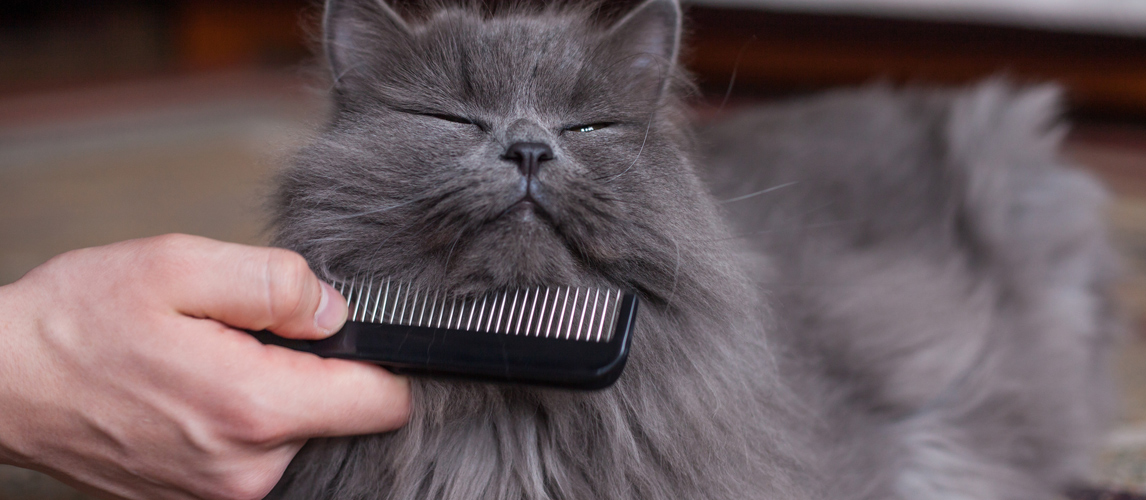

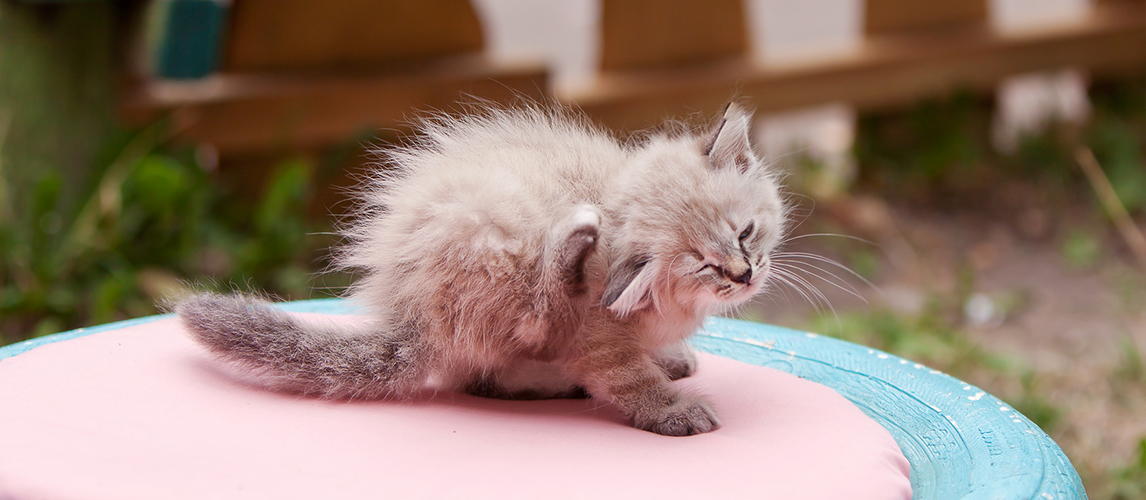



Very informative & written in an easy to understand way.